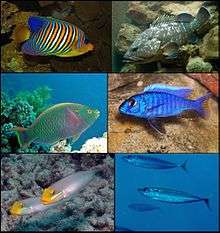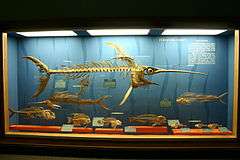Perciformes
| Perciformes | |
|---|---|
 | |
| Scientific classification | |
| Kingdom: | Animalia |
| Phylum: | Chordata |
| Class: | Actinopterygii |
| Superorder: | Acanthopterygii |
| Order: | Perciformes Bleeker, 1863 |
| Type species | |
| Perca fluviatilis | |
| Orders | |
|
See text | |
Perciformes, also called the Percomorpha or Acanthopteri, is an order or superorder of ray-finned fish. If considered a single order, they are the most numerous order of vertebrates, containing about 41% of all bony fish. Perciformes means "perch-like". This group comprises over 10,000 species found in almost all aquatic ecosystems.
The order contains about 160 families, which is the most of any order within the vertebrates.[1] It is also the most variably sized order of vertebrates, ranging from the 7-mm (1/4-in) Schindleria brevipinguis to the 5-m (16.4 ft) marlin in the genus Makaira. They first appeared and diversified in the Late Cretaceous.
Among the well-known members of this group are perch and darters (Percidae), sea bass and groupers (Serranidae), mackerel and tuna (Scombridae), billfish (Xiphiidae and Istiophoridae), and icefish (Nototheniidae).
Characteristics
The dorsal and anal fins are divided into anterior spiny and posterior soft-rayed portions, which may be partially or completely separated. The pelvic fins usually have one spine and up to five soft rays, positioned unusually far forward under the chin or under the belly. Scales are usually ctenoid, although sometimes they are cycloid or otherwise modified.
Taxonomy
Classification is controversial. As traditionally defined before the introduction of cladistics, the Perciformes are almost certainly paraphyletic. Other orders that should possibly be included as suborders are the Scorpaeniformes, Tetraodontiformes, and Pleuronectiformes. Of the presently recognized suborders, several may be paraphyletic, as well. These are grouped by suborder/superfamily, generally following the text Fishes of the World.[1][2][3]

|
References
| Wikimedia Commons has media related to Perciformes. |
| Wikispecies has information related to Perciformes |
- 1 2 3 Nelson, J. S. (2006). Fishes of the World (4 ed.). Hoboken, NJ: John Wiley & Sons. ISBN 978-0-471-25031-9.
- ↑ Froese, Rainer, and Daniel Pauly, eds. (2015). "Perciformes" in FishBase. August 2015 version.
- ↑ "ADW: Perciformes". animaldiversity.ummz.umich.edu. Animal Diversity Web.
- ↑ R. Betancur-Rodriguez, E. Wiley, N. Bailly, A. Acero, M. Miya, G. Lecointre, G. Ortí: Phylogenetic Classification of Bony Fishes – Version 4 (2016)
